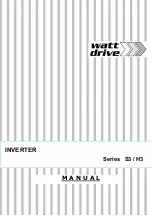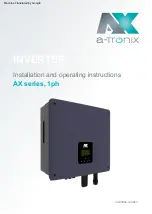
7
TROUBLESHOOTING
Common Audio/Visual Problems
“Buzzing” sound in audio systems
Some inexpensive stereo systems and “boom boxes” emit a buzzing sound from their
speakers when operated from the Power Inverter. This occurs because the power
supply in the electronic device does not adequately filter the modified sine wave
produced by the inverter. The only solution to this problem is to use a higher quality
sound system that incorporates a higher quality power amplified supply.
Television Interference
The Inverter is shielded to minimize interference with TV signals. However, in some
instances, some interference may still be visible, particularly with weak TV signals. Try
the following corrective measures:
• Position the inverter as far as possible from the television, the antenna and the
antenna cables. Use an extension cable, if necessary.
• Adjust the orientation of the inverter, the antenna cables and the TV power cord to
minimize interference.
• Make sure that the antenna feeding the television provides an adequate (“snow
free”) signal and that high quality, shielded antenna cable is used.
Fault Protection Code and Troubleshooting Guide
INVERTER POWER SWITCH TURNED ON
Trouble/Indication
Possible Cause
Suggested Remedy
No AC output — green
LED flashes
DC input is out of
range
Recharge or replace the
battery.
Excessive load —
thermal shutdown
Turn unit off. Reduce the
load, wait for the inverter to
cool down, then turn the
unit on again.
Fault condition from
AC short circuit
Disconnect appliance and
clear wiring.
Motorized power tool will
not start
Excessive start-up
load
If appliance does not start,
appliance is drawing
excessive voltage and will
not work with inverter.
Motorized power tool
does not operate at
correct speed
Purely inductive load
Make the load not purely
inductive (i.e., operate an
incandescent lamp at the
same time as motor).
Television/radio
interference
Snow in picture,
“buzzing” sound
Keep inverter and antenna
distant from each other. Use
shielded antenna. Connect
antenna to amplifier.
6
Battery Operating Time
An operating time of 2 to 3 hours can be expected from a typical vehicle battery.
In most instances, 5 to 10 hours of operating time is achievable. However, the
manufacturer recommends that the operator start the vehicle every 2 to 3 hours to
recharge the vehicle’s battery system. This will guard against any unexpected
shutdown of the equipment and will ensure there is always sufficient battery capacity
to start the vehicle’s engine. The inverter will shut down when DC voltage drops below
10.6 volts.
The inverter may be used whether or not the vehicle’s engine is running. However, the
inverter may not operate while the engine is starting, since the battery voltage can
drop substantially during cranking.
The inverter draws less that 0.5 ampere from the battery when it is not supplying
power to a load. In most instances, the inverter can be left connected to the battery
when not in use, since it draws so little current. However, if the vehicle is to remain
unused for several days, disconnect the inverter from the battery.
Operation of the USB Power Port
1. Position the inverter for use, observing all cautions and warnings in the
“Important Safety Instructions” section at the front of this manual.
2. Connect the 12 Volt DC Accessory Cord’s small rectangular plug to the inverter’s
12 Volt DC Power Port.
3. Insert the other end of the 12 Volt DC Accessory Cord into a vehicle’s accessory
outlet or other 12 volt DC power source.
4. Rotate the vehicle accessory plug slightly to make sure there is good contact.
5. If the inverter does not work, make sure the ignition/accessory outlet is powering
the accessory outlet. Some vehicles require the ignition switch to be turned on.
6. Plug the USB-powered device into the inverter’s USB Power Port and operate
normally.
Notes:
This inverter’s USB Power Port does not support data communication. It only
provides 5 volts/500mA (maximum) DC power to an external USB-powered
device.
USB power output is controlled by the ON/OFF Power Switch.
CARE AND MAINTENANCE
Storage
1. Ideal storage temperature range is 50-68°F (10-20°C).
2. Store and use the inverter in a cool, dry place with adequate ventilation.
3. Avoid locations that are exposed to heating units, radiators, direct sunlight or
excessive humidity or dampness.
Maintenance
This unit contains no user-serviceable parts. It is recommended that the unit be
returned to manufacturer for service (see the Warranty for repair/replacement policy
and contact information).
PI500CP_ManualEN_010807 1/8/07 4:48 PM Page 6
























